SaaStr Annual 2018 Review: Key Takeaways and Ideas Worth Spreading
One of the signs that the New Year is here is that our team’s calendars get all filled up with new industry events. We are no stranger to attending conferences, and in fact, strive to visit at least 5 great tech events annually.
Why is that?
First of all, continuous education is the backbone of our company culture. We encourage everyone to obtain new certifications regularly, attend workshops, go and study online or just prompt your manager that there’s this one great business book you were eyeing…and watch it arrive in a few days.
Participating in industry events, however, gives you an extra advantage – the opportunity to mingle and exchange ideas with your peers; get a fresh perspective on things; connect with like-minded fellows and score some business development opportunities.
Recently, Romexsoft team was spotted taking notes, attending workshops and getting a nightcap with other participants of Web Summit, The Next Web, IT Arena, Amsterdam Capital Week and Startup Safary Berlin.
This year, we keep the streak going and headed to San Francisco for SaaStr Annual 2018 Conference — the biggest confab for B2B and SaaS founders, execs, and VCs.
Table of Contents
So What is SaaStr and SaaStr Annual?
To recap, SaaStr began back in 2012 as a simple WordPress blog by Jason M. Lemkin, where he documented his path from $0 to $100m ARR and shared the insights learned along that way.
Today, this pet project has grown into the world’s largest community of SaaS founders and entrepreneurs. The blog gets 3M views per months and a dedicated Quora account has over 37 million views. In 2015, the SaaStr team also moved on to hosting various in-person events throughout the year including SaaStr Annual – a 3-day event, action-packed with talks; networking opportunities with peers, VCs, Execs and everyone in between; and of course the finest evening fun.
To give you more background, the top speakers’ at SaaStr 2018 were Stewart Butterfield, CEO of Slack, Dharmesh Shah and Katie Burke from Hubspot, Michael Pryor, CEO and Head of Product of Trello & Atlassian; Sarah Bird, CEO of MOZ; Aileen Lee, Founder & Partner at Cowboy Ventures and a bunch of other incredible folks who should forgive us for not mentioning them by name for the sake of keeping this post to the point. ☺
In fact, choosing among the 5 stages and hopping between the parallel sessions was among the toughest things for our team. This year’s agenda was just over-packed with great stuff. Not complaining though. Eventually, our team split up and attended certain events separately exchanging the tips and advice later in the day. This post rounds up the most valuable lessons picked up from SaaStr Annual in San Francisco.
Halyna Levko, Head of Sales and Marketing at Romexsoft
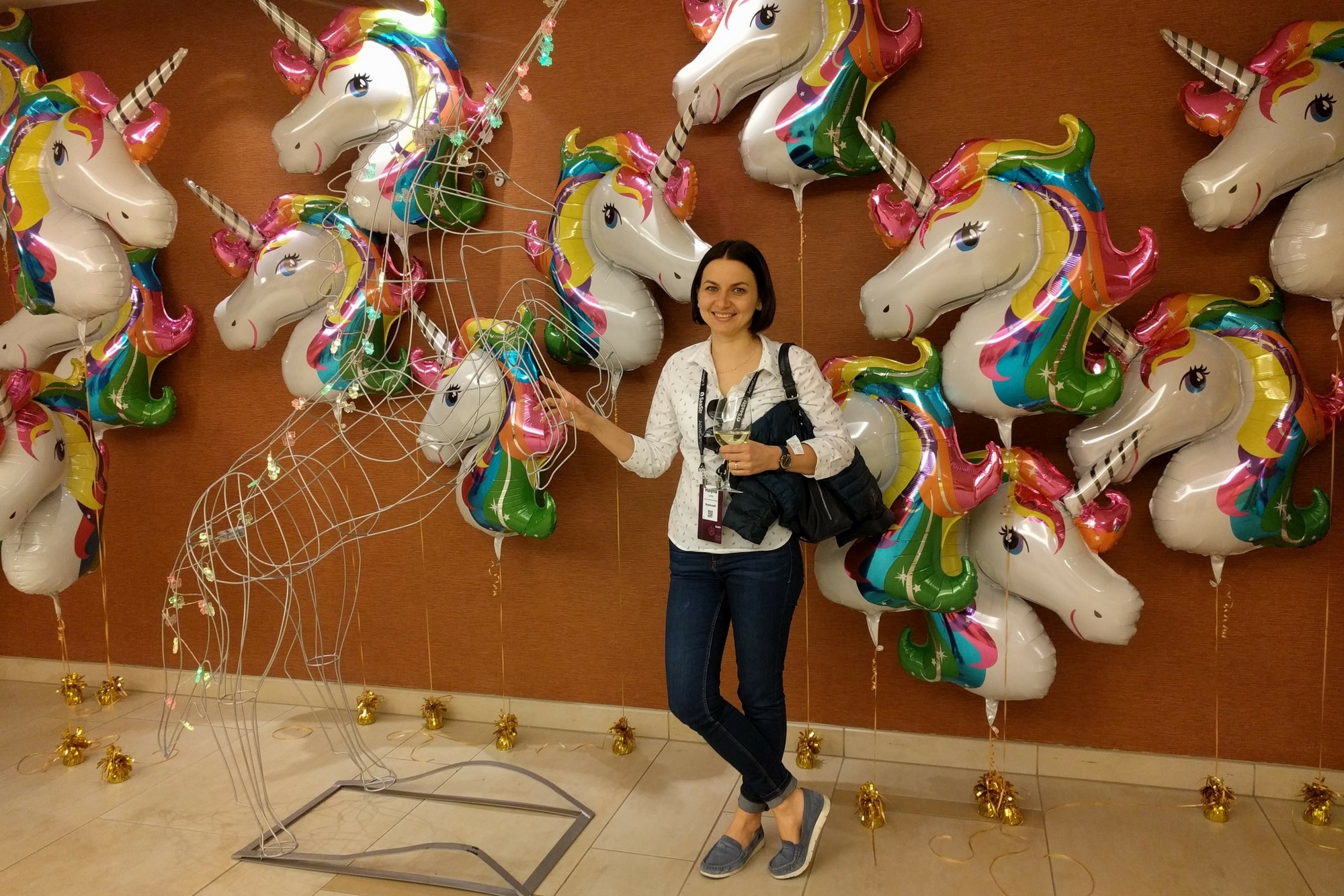
I really need to catch my breath and properly digest everything learned at SaaStr Annual. The scale of the event was grand. This year’s venue and location were a primer. The Hilton Hotel in San Francisco has set this high bar – when you end up in a place like that, you know it’s going to be a massive event.
SaaStr organizers really invested in communicating their culture and nurturing this great community of remarkable folks. If you are an IT industry leader, you just have to sign up for SaaStr Annual 2019. It’s a must-attend event, so mark up the dates on your calendar.
I really admired the event’s diversity – you could shake hands with people from all around the world; and rub elbows with the top CEOs, founders, CTOs, and Senior Execs.
I’ll briskly sum up some other cool things beyond the presentations themselves:
- Brain Dates: anyone could suggest a topic and invite peers to participate in the discussion through the conference app. This created a really great opportunity to connect and exchange ideas with people of all backgrounds. Considering the event’s scale, that would not have been so easy to do otherwise.
- The talks were more visionary and change-oriented, rather than purely hands-on. You were forced to think whether you should apply this insight to your company and how it may work out, rather than prompted to follow a cookie-cutter method that worked for someone.
Now, concerning the speakers, I was most inspired by Jason Cohen – CTO & Co-Founder / WP Engine and his talk: Facing Some Difficult Truths: From burnout to $100M in ARR with WP Engine.
So most founders burn out just because everything is tied upon them, they take all the key decisions. Alone.
Why does this happen?
Well, each person wants to be accomplished and given credit for her work. She feels truly accomplished when she does it herself. Hence, delegating anything becomes a nightmare.
So this person thinks he’s a Type A person and he wants to hire a person of the same class to be in charge of some process – say marketing. Yet, once he starts looking for the right match, he has this feeling that he first needs to understand the subject himself. But who can become an expert in the field fast? Few people, indeed. As a result, the leader chooses someone based on their own low level of knowledge – not exactly a Type A kind-of-person or just someone who’s not fit to do the job. And that’s where you fail.
A leader can’t stay accountable for everything. And often can’t see on his own where he made a mistake.
It’s important to admit to yourself that you can delegate. That there are people, who will understand certain things better than you do and it’s okay.
“You should be an editor, not a writer“.
Next, there’s this – a founder must be a happy person. But how do we get there?
Well, long story short there are three types of activities we engage in:
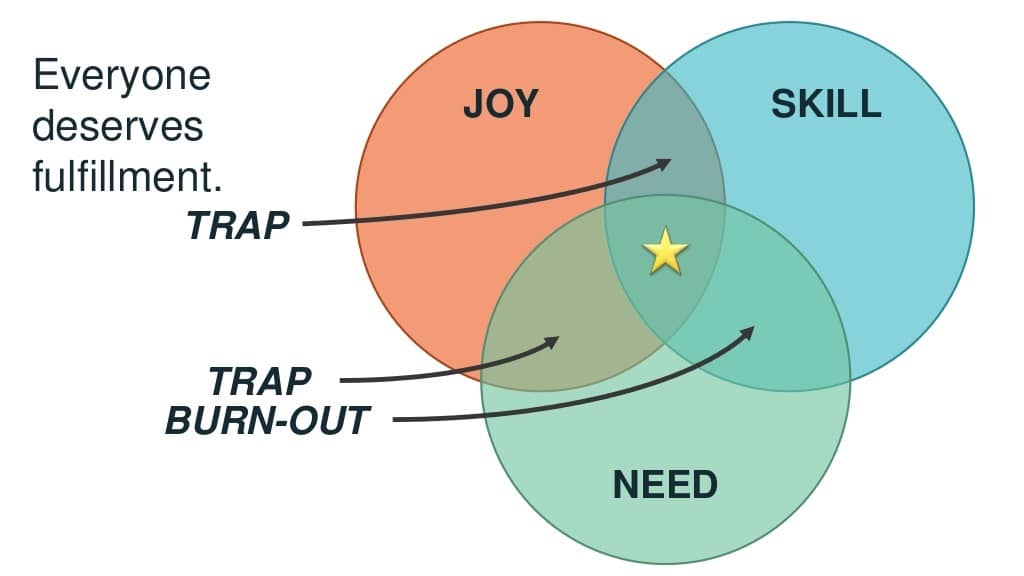
- The one that makes us happy and gives us a feeling of accomplishment.
- The one that we do as we have skills for that.
- The one that we need to do.
When we try to combine those three activities, we face three types of traps:
- Joy + Skills – something that is fulfilling, but does not help the company much.
- Joy + Need – something that is fulfilling and useful for the company, but you don’t have enough skills to do that. This is what you should delegate to the pros.
- Need + Skills – and this one just leads to burnout.
When you manage to place all your tasks in these categories and delegate the right ones while focusing on accomplishing only those that are placed in the intersection of these three activities, your company will not only become successful, but it will become successful thanks to you.
Serhiy Kozlov, CEO at Romexsoft
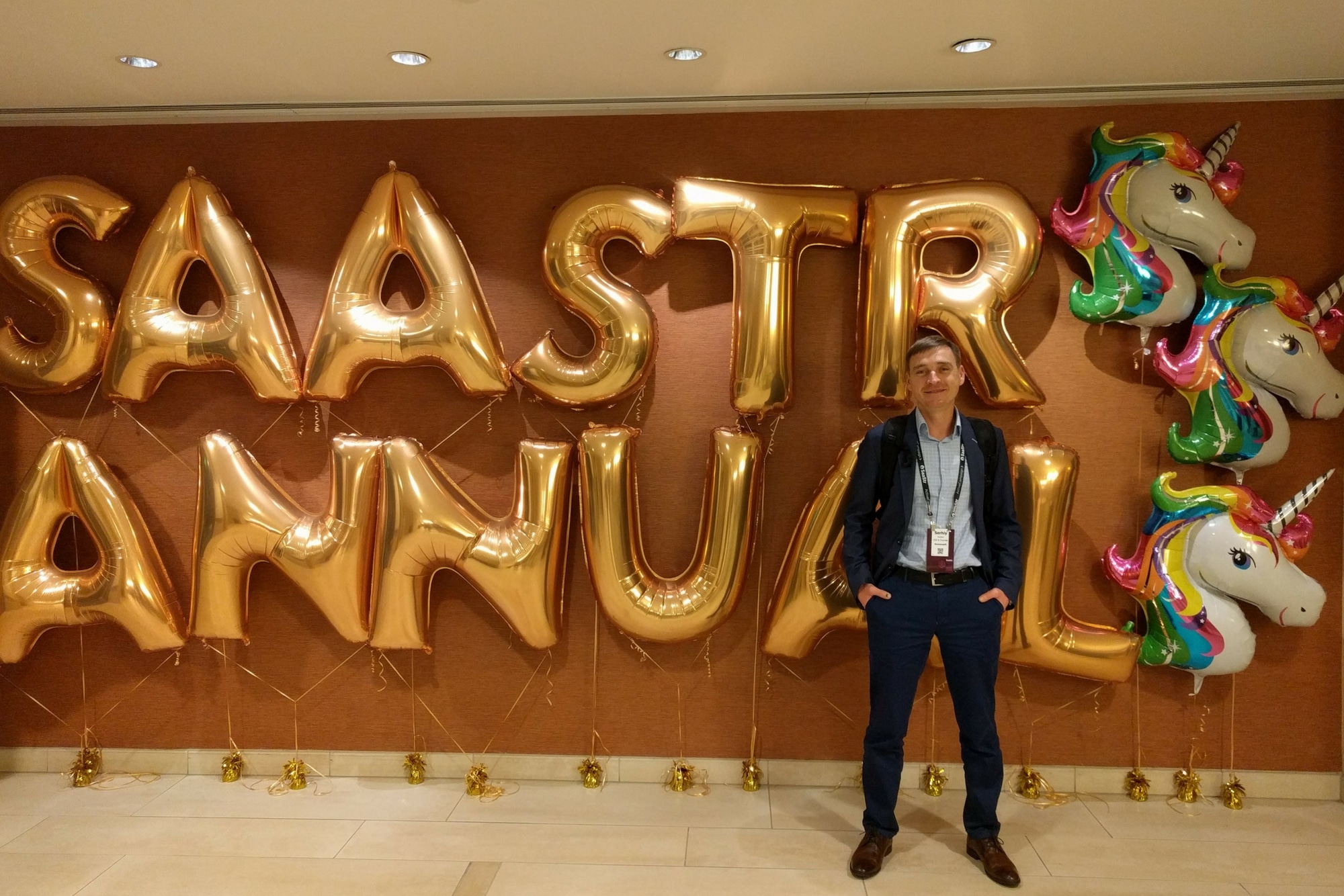
The ideas shared by speakers at SaaStr 2018 were monumental. You were challenged to think deeper and look at the common problems from a new angle. I’ll go straight to the point and highlight the lessons from two talks I admired a lot.
Culture Lessons: What worked and what didn’t at HubSpot. Speakers Dharmesh Shah – CTO & Founder / HubSpot, Katie Burke – Chief People Officer / HubSpot.
The main takeaway here is that the company culture isn’t just some element to add to your company strategy and kind of forget about it. “Culture is a product you build. Your people are its customers,” – so don’t forget that.
Great company culture is the cornerstone of assembling powerful teams. Think about it this way – no matter how epic your marketing is, the customer won’t snatch it if the product is junk, right? Company culture is what your recruiters “sell” to the candidates. If it’s non-existent than your efforts to retain top-performers will fail shortly too.
The lack of company culture also leads to micromanagement. Neither you nor your employees need that.
If you are struggling to define your company culture, ask your peers’ opinion. What do they think of your company image? However, be ready to take immediate action upon the feedback you receive, as lack of any action will only lead to aggravations.
To sum it – “culture is the operating system of your company”. Schedule regular maintenance unless you want to deal with massive system glitches.
P.S. I’d also like to point out how friendly and available all the speakers were. You could easily chat up Hubspot’s CTO on the latest trends in marketing or anything else you would really want to know.
The second talk I’d like to highlight is – In Conversation with Ryan Smith: Build a Unicorn the Hard Way – and the Right Way with Qualtrics.
Ryan is the CEO of Qualtrics and recently made it to Fortune: 40 under 40 lists. His experience in running and building an online survey company now boasting 1,200 employees and a valuation of more than $1 billion is just mind-boggling.
Here’s Ryan advice that all novice entrepreneurs should really listen to – don’t look for the mentors who are top in business only; connect with mentors who have succeeded in multiple areas – they run a profitable company, have a good family, have enough time for friends, etc. Basically, those who have successfully managed all aspects of their life.
Being successful in one area is not that hard. Yet staying awesome in everything – now that’s a true challenge! The latter assumes you can manage your time properly, be empathic and balance multiple chores without burning out.
Michael Salo, COO at Romexsoft
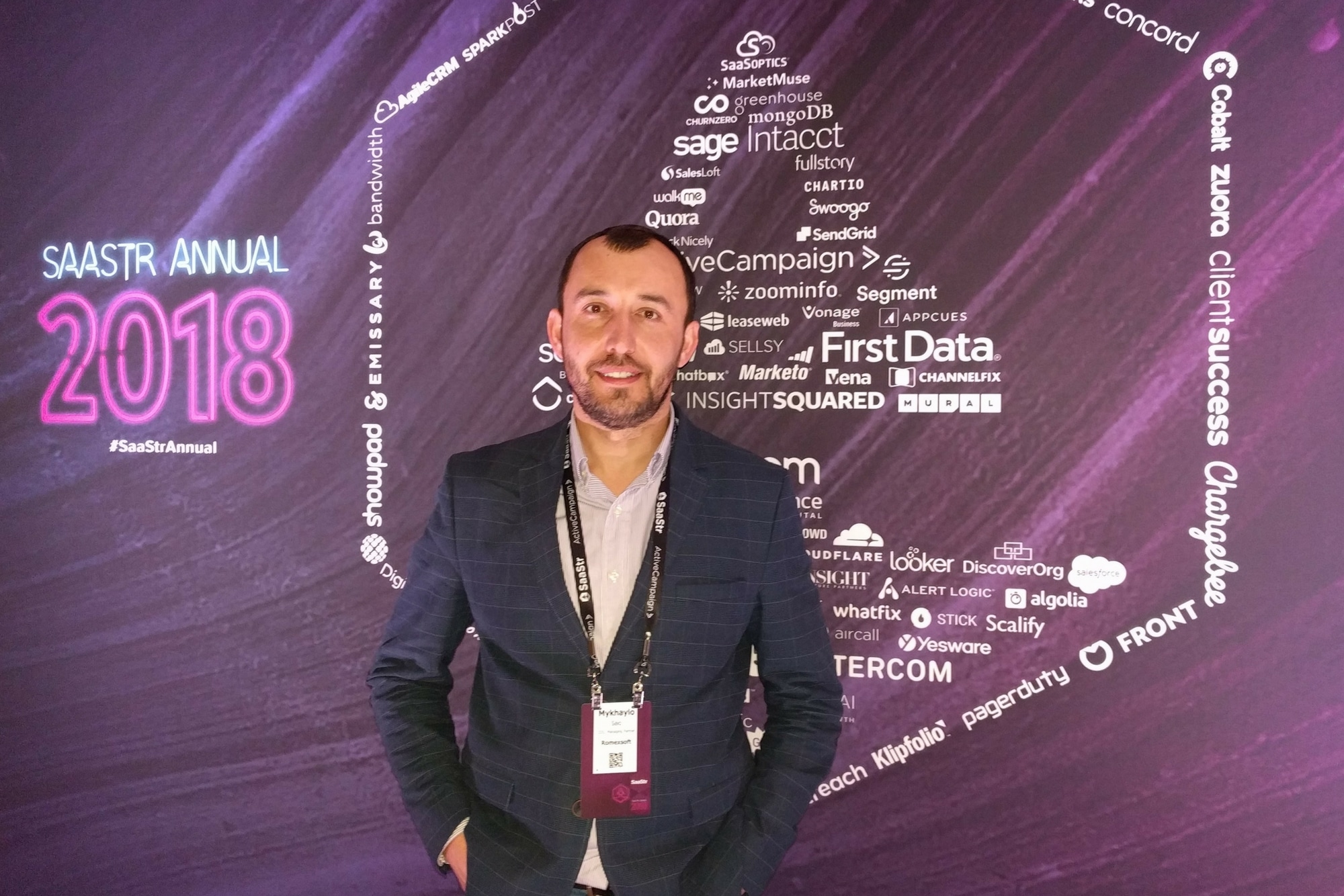
SaaStr organizers did a great job this year. I was particularly impressed with:
- The sheer scale of the event: there were so many speakers and participants this year. The conference was held in five parallel sessions. A lot of action.
- Community: the vibe was powerful.
- SaaStr App: The event’s official app was super handy to navigate around and connect with other participants.
The two top speakers I admired the most were …
Conversation with Ryan Smith: Build a Unicorn the Hard Way – and the Right Way with Qualtrics. Ryan Smith – CEO / Qualtrics.
Considering that I’m now in charge of developing an advisory board, it was important for me to hear that you indeed need to enlist different people, who are experts in their areas, rather than try to find a “jack-of-all-trades” kind of expert.
Another key life lesson I picked up from Ryan is this — “Balance is never flat”.
Everyone looks for the right life balance between the private and the business. However, everything in life happens in waves. At one point, one aspect will overweight another one, and vice versa. But that’s okay. You don’t need to always strive for things to be perfect.
To maintain a proper life balance, you need to learn how to build duplexes or even triplexes. For instance, you have two or three seemingly incompatible tasks that you need to do here and now. So you need to learn to bring them all together in an attractive synergy. For instance – you were invited to give a conference talk, but your wife says you are already spending too little time with the kids. So why shouldn’t you bring the family along? You can attend your event and then take an extra day off to spend some quality time with the family.
Jumpstart: How to Measure the ROI of HR with Greenhouse by Maia Josebachvili – VP of Marketing & Strategy / Greenhouse Software:
Maia has introduced a very curious concept, close to my activities – the employee lifetime value (ELTV). During their time at your organization, an employee goes through the next stages:
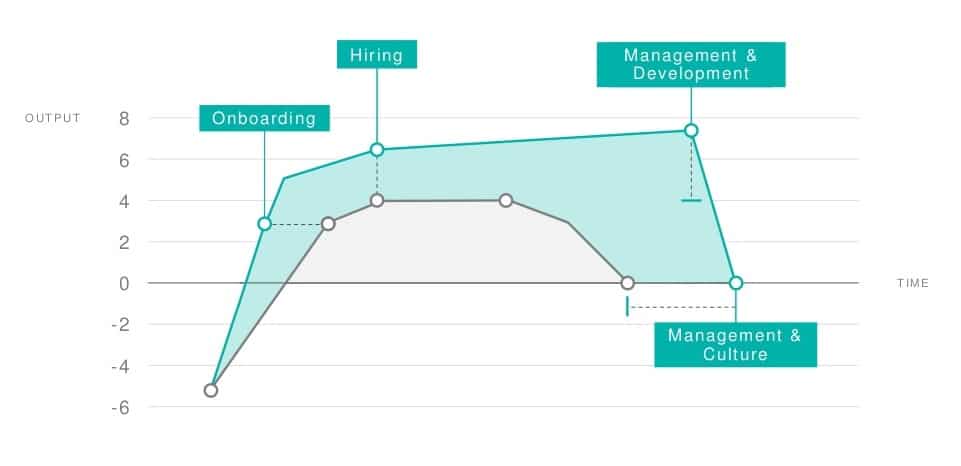
Source: Greenhouse
Each of these stages can be improved by “pressing the right buttons”. However, it all starts with recruiting the right candidates. In fact, recruiting has a direct impact on revenues. Superior practices can contribute to more than 3x revenue growth and 2x profit margins.
When you hire the right candidates, you reduce the onboarding time and have the person fully productive within a shorter time span. Next, it is important to understand and anticipate the reasons why an employee will want to leave. In most cases, their decision has something to do with the gaps in the company culture and/or managerial processes.
And here we are back to the points mentioned in Hubspot’s speech – nurturing great company culture is essential for long-term success. We are definitely taking that as the 2018 mantra at Romexsoft.
About Romexsoft
Romexsoft is a software development company dedicated to Java applications with our own development center located in Lviv, Ukraine and a client base around Europe and the USA.
During the last 13 years we’ve developed and successfully delivered more than 100 projects to our clients in Fintech, Healthcare, and Broadcast Media industries.
We are obsessed with innovations and their implementation into our processes, so we could provide effective and market competitive solutions to industry leaders and startups with creative ideas.
Learn more at romexsoft.com and contact us to get more insights.
Written by Romexsoft on February 16, 2019
